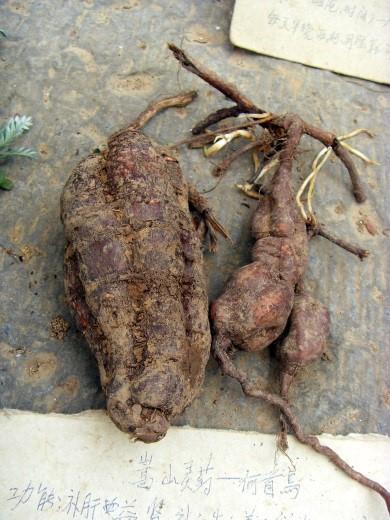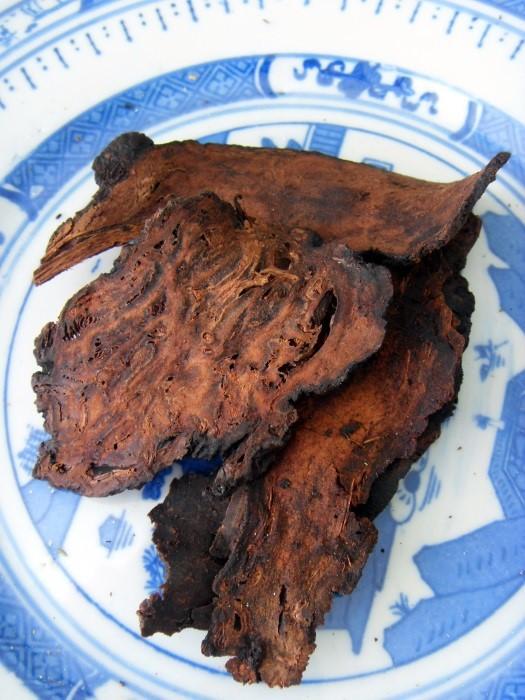Name
Latin Name: Radix Polygoni MultifloriCommon Name: Fleeceflower root  Scientific Name: Polygonum multiforum Thunb.
Scientific Name: Polygonum multiforum Thunb.
Chinese Name: 何首烏Pinyin Name: he shou wu
Origin
Fleeceflower root is the root tuber of Polygonum multiforum Thunb., a perennial herbal plant of the Polygonaceae family. The root is used either in dried form or processed by steaming with black soybean juice. Its vine stem and leaf have medicinal actions too.1,2
Where Does It Grow?
Fleeceflower root is widely disturbed in China. It is now mainly cultivated and produced in provinces like Henan, Hubei, Guizhou, Sichuan, Jiangsu, and Guangxi. Others like Zhejiang, Anhui, Guangzhou, Shandong, Jiangxi and Hunan are also produced. 5,6
Nature and Flavor
Fleeceflower root is neutral in nature, sweet and bitter in flavor, and mainly manifests its therapeutic actions in the liver, heart and large intestine meridians. After processed, it becomes mild warm in nature, sweet and astringent in flavor, and mainly manifests its therapeutic actions in the liver and kidney meridians. Clinically, processed fleeceflower root is more often used.
2
Identified Active Components / Major Chemical Constituents
Ingredients in fleeceflower root are mainly anthraquinone compounds (about 1.1%) such as emodin, chrysophanol, physcion, rhein, and chrysophanol anthrone; stilbenes such as resveratrol, piceid, 2,3,5,4'-Tetrahydroxystilbene-2-O-D-glucoside; and also starch (45.2%), crude fat (3.1%), and lecithin (3.7%). It also contains gallic acid, catechin, epicatechin, and β-sitosterol, and has rich trace elements like manganese, calcium, zine and iron.1,5,6
In the Pharmacopoeia of People's Republic of China (2010 Edition) - Part I, the level of anthraquinone compounds (mainly emodin and physcion) should not less than 0.05%; while the 2,3,5,4'-Tetrahydroxystilbene-2-O-D-glucoside (C20H22O9) should not less than 1.0%, which are the standard qualities of fleeceflower root.

Drug Actions in TCM
Processed fleeceflower root replenishes essence and blood, fortifies kidney and darkens hair. Dried fleeceflower root relieves toxicity, lubricates intestines and promotes bowel movements.2,4
Traditional Uses in TCM
Fleeceflower root is often used to treat dizziness, lumber and knee weakness, general soreness, seminal emission, excess menses, premature graying, chronic malaria, chronic diarrhea, abscess, skin sores, itchiness, constipation, piles and high blood lipid.2,3
•Processed fleeceflower root is a commonly used tonic herb
Blood deficiency leads to sallow complexion, insomnia and forgetfulness, processed fleeceflower root can work together with processed rehmannia root, angelica root and sour jujube seed to replenish blood and calm down spirit. Yin deficiency of liver and kidney that causes dizziness, blurred vision, seminal emission, lumber and knee weakness, premature aging and early grey hair, the herb can work with processed rehmannia root, angelica root, wolfberry, cornus fruit, dodder seed, glossy privet fruit, and yerbadetajo herb to nourish the liver and kidney systems. A representative formula of this is the Seven Treasures Hair Beauty Pill. Processed fleeceflower root is an important herb for mental enhancement, for conditions like sleep disorders, dream-disturbed sleep, poor memory, poor attention, dizziness and headache, it can be combined with sour jujube seed, Chinese arborvitae kernel, red sage root and schisandra and prepared as pills for regular consumption.
Generally, the herb is a mild tonic that suitable for long-term consumption, even for those with a sensitive body. Modern TCM often uses the herb for conditions like hypertension, high blood lipid and coronary heart disease that present with the above symptoms (yin deficiency of liver and kidney). In the remedies, processed fleeceflower root is likely to be combined with red sage root, mulberry mistletoes, hawthorn fruit, glossy privet fruit, and reishi mushroom. A representative formula is the Fleeceflower Root Anti-aging Pill.
•Fleeceflower root (unprocessed) lubricates intestines and promotes bowel movements
Constipation in the elderly, chronic diseases, and postnatal are usually due to blood and body fluid depletions, dried fleeceflower root is therefore suitable for them, as well as for those with piles that have anal bleeding and difficulty in passing stools. Fleeceflower root used alone is usually well enough to have the result, but will be better if combining with rehmannia root, angelica root, black sesame, and hemp seed.
•Fleeceflower root (unprocessed) relieves toxicity and dissipates nodulation
TCM physicians may use the herb to treat scrofula (lymph node infections in the neck and is associated with tuberculosis), other herbs like selfheal fruit spike, paniculate bolbostemma rhizome, and oyster shell are often added in the remedies. In cases of abscesses and skin sores, the herb may be used with dandelion, weeping forsythia capsule and figwort root.
•Fleeceflower root nourishes the body and cuts malaria attack
Malaria individuals that last for a long time usually result in a depleted state, it is indicated to use the herb along with ginseng (or pilose asiabell root) and angelica root. Otherwise, fleeceflower root (in high dose 30g) may be added in the Minor Bupleurum Decoction and then modified according to individual symptoms for the same therapeutic purpose.
•Fleeceflower root treats hives and itchy skin
Skin itchiness is usually associated with internal wind that generated by an over-dried blood condition, and dried fleeceflower root is often indicated. The herb may be combined with angelica root, ledebouriella root, dictamnus root bark, sopora root and schizonepeta herb for the treatment. For external usage, the herb can be decocted with Chinese mugwort leaf for washing.
Pharmacological Actions
Modern researches showed that fleeceflower root has effects in lowering blood lipids and sugar, preventing atherosclerosis, immune enhancement, expanding blood vessels, promoting adrenal gland secretion and blood cell productions, smooth heart and brain circulations, protecting liver functioning, enhancing neural and bowel transmissions, promoting hair growth, anti-septic and anti-aging. 4
Toxicology
Dried fleeceflower root solution (alcohol percolation extraction method) administered by gavage to mice, the LD50 was found to be 50g/kg, when injected (i.p.) in mice, the LD50 was found to be 2.7g/kg. Processed fleeceflower root solution (same extraction method) administered by gavage to mice, no death is found even in 1000g/kg. The results indicate that fleeceflower root has certain toxicity, but can be cleared after processed.4
Administration and Dosage
For decoction, fleeceflower root is suggested in 9~15g, it can be as high as 20~30g if necessary. The herb is also made in syrup, tincture, pill and powder preparations. Dried fleeceflower root is also decocted for washing or ground for topical dressing.3,4
Adverse Effect, Side Effects and Cautions
For those with diarrhea, low appetite, a thick tongue coating or gastritis, fleeceflower root is not indicated. It has showed that when giving processed fleeceflower root at a dose of higher than 12g to them, their gastric pain, appetite and other digestive symptoms may be aggravated, and thus it should be with caution for the individuals.5,6
Clinically demonstrations show that in healthy individuals and as decocted form, it is safe to take processed fleeceflower root within the suggested dosage or high dose (<30g), there is no adverse response even for long-term consumption. Moreover, it is usually safe to use dried fleeceflower root for promoting bowels and relieving toxicity, but when the individual is too weak, there may be gastric and abdominal pain, and diarrhea. Overdose in dried fleeceflower root can cause abdominal pain, nausea, vomiting, some may even have skin rash and fever.4
References
- Li Jiashi (editor-in-chief), Chinese Medicine Identification, Shanghai Scientific and Technical Publishers, 2000-2.
- Lui Daiquan (editor-in-chief), Chinese Herbal Medicine, Shanghai Scientific and Technical Publishers, 2000-6.
- Tao Yufeng, Clinical Herbal Medicine, People’s Medical Publishing House, 2005-5.
- Chen Pian, Clinical Application of Tonifying Herbs, Second Military Medical University Press, 2008-8.
- http://baike.baidu.com/view/6256.htm?fr=aladdin
- <spanhttp://www.zysj.com.cn/zhongyaocai/yaocai_h/heshouwu.html




